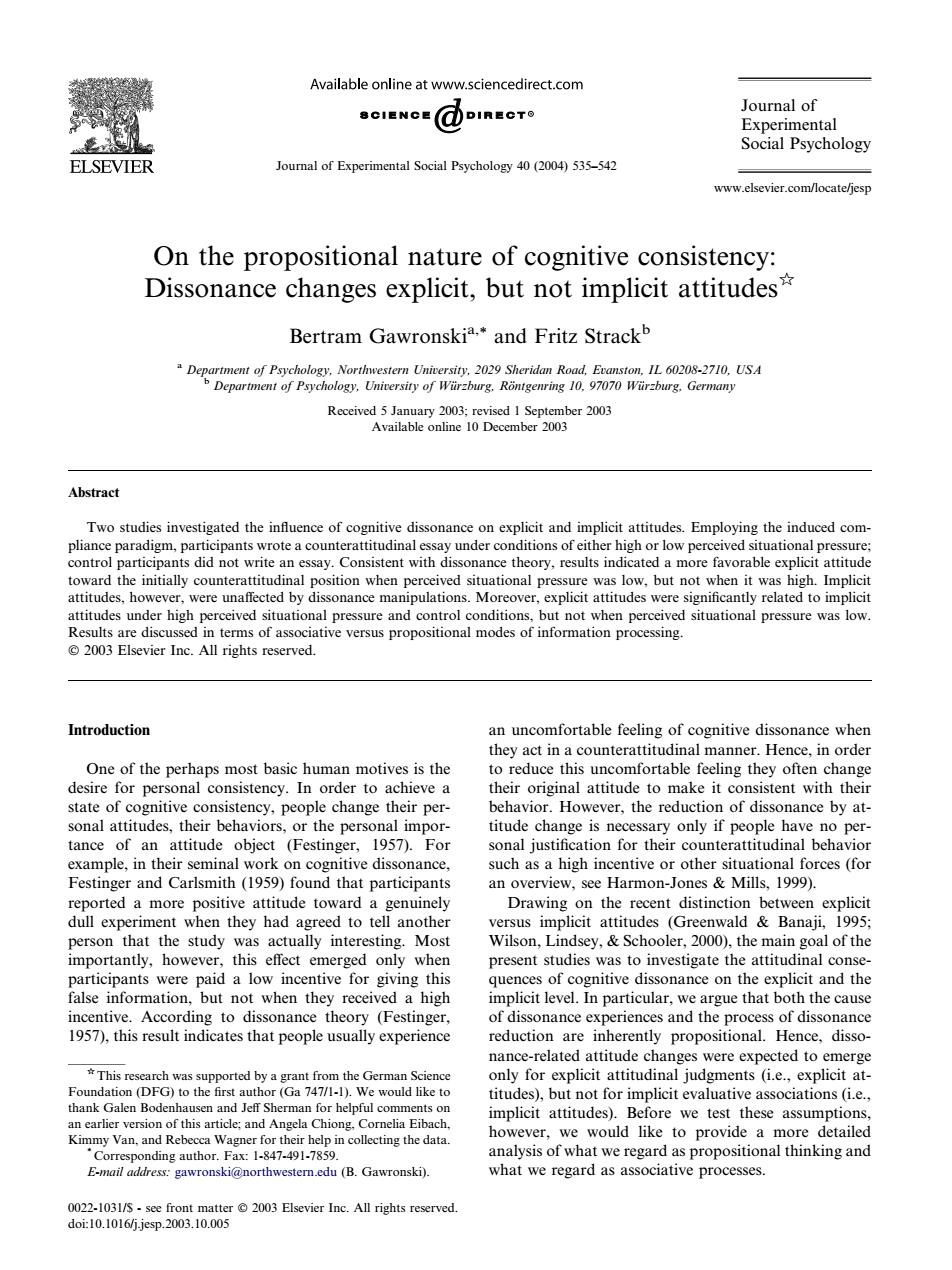正在加载图片...

Available online at www.sciencedirect.com Journal of ELSEVIER Joumal of Experimental Social Psychology 4(2004)535-542 www..com/ocate/jesp On the propositional nature of cognitive consistency: Dissonance changes explicit,but not implicit attitudes Bertram Gawronski and Fritz Strackb Abstract Two studies investigated the influence of cognitive dissonance on explicit and implicit attitudes.Employing the induced com ceived situational pressure and control conditions. but not when perceived situational pressure was low Introduction an uncc nfortable feeling of cognitive dissonance when motives is the their original attitude to make it consistent with thei state of otive consisteney.people change their per r.However,the reduction of dissonance by at sonal a the pers 1957 essary only people have no per example.in their seminal work on cognitive dissonance such as a high incentive or other situational forces (for Festinger and Carlsmith(1959)found that participants an overview,see Harmon-Jones Mills,1999). Drwin on the be ey ne al of the however.this effect emerged only when present studies was to investigate the attitudinal conse cinrnts were phud a low incenote os s ng this quences of cognitive dissonance on the explicit and the ation, not when they recei icit lev we argue that bo he caus reduction are inherently propositional.Hence.disso nance-related attitude changes were expected to emerge only hank Gakn Bod licit attitudes however.we would like to provide a more detailed Reb C-ma s(B.)On the propositional nature of cognitive consistency: Dissonance changes explicit, but not implicit attitudesq Bertram Gawronskia,* and Fritz Strackb a Department of Psychology, Northwestern University, 2029 Sheridan Road, Evanston, IL 60208-2710, USA b Department of Psychology, University of Wu€rzburg, Ro€ntgenring 10, 97070 Wu€rzburg, Germany Received 5 January 2003; revised 1 September 2003 Available online 10 December 2003 Abstract Two studies investigated the influence of cognitive dissonance on explicit and implicit attitudes. Employing the induced compliance paradigm, participants wrote a counterattitudinal essay under conditions of either high or low perceived situational pressure; control participants did not write an essay. Consistent with dissonance theory, results indicated a more favorable explicit attitude toward the initially counterattitudinal position when perceived situational pressure was low, but not when it was high. Implicit attitudes, however, were unaffected by dissonance manipulations. Moreover, explicit attitudes were significantly related to implicit attitudes under high perceived situational pressure and control conditions, but not when perceived situational pressure was low. Results are discussed in terms of associative versus propositional modes of information processing. 2003 Elsevier Inc. All rights reserved. Introduction One of the perhaps most basic human motives is the desire for personal consistency. In order to achieve a state of cognitive consistency, people change their personal attitudes, their behaviors, or the personal importance of an attitude object (Festinger, 1957). For example, in their seminal work on cognitive dissonance, Festinger and Carlsmith (1959) found that participants reported a more positive attitude toward a genuinely dull experiment when they had agreed to tell another person that the study was actually interesting. Most importantly, however, this effect emerged only when participants were paid a low incentive for giving this false information, but not when they received a high incentive. According to dissonance theory (Festinger, 1957), this result indicates that people usually experience an uncomfortable feeling of cognitive dissonance when they act in a counterattitudinal manner. Hence, in order to reduce this uncomfortable feeling they often change their original attitude to make it consistent with their behavior. However, the reduction of dissonance by attitude change is necessary only if people have no personal justification for their counterattitudinal behavior such as a high incentive or other situational forces (for an overview, see Harmon-Jones & Mills, 1999). Drawing on the recent distinction between explicit versus implicit attitudes (Greenwald & Banaji, 1995; Wilson, Lindsey, & Schooler, 2000), the main goal of the present studies was to investigate the attitudinal consequences of cognitive dissonance on the explicit and the implicit level. In particular, we argue that both the cause of dissonance experiences and the process of dissonance reduction are inherently propositional. Hence, dissonance-related attitude changes were expected to emerge only for explicit attitudinal judgments (i.e., explicit attitudes), but not for implicit evaluative associations (i.e., implicit attitudes). Before we test these assumptions, however, we would like to provide a more detailed analysis of what we regard as propositional thinking and what we regard as associative processes. q This research was supported by a grant from the German Science Foundation (DFG) to the first author (Ga 747/1-1). We would like to thank Galen Bodenhausen and Jeff Sherman for helpful comments on an earlier version of this article; and Angela Chiong, Cornelia Eibach, Kimmy Van, and Rebecca Wagner for their help in collecting the data. * Corresponding author. Fax: 1-847-491-7859. E-mail address: gawronski@northwestern.edu (B. Gawronski). 0022-1031/$ - see front matter 2003 Elsevier Inc. All rights reserved. doi:10.1016/j.jesp.2003.10.005 Journal of Experimental Social Psychology 40 (2004) 535–542 www.elsevier.com/locate/jesp Journal of Experimental Social Psychology